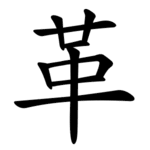| 革 | ||
|---|---|---|
| ||
| 革 (U+9769) "leather, rawhide" | ||
| Pronunciations | ||
| Pinyin: | gé | |
| Bopomofo: | ㄍㄜˊ | |
| Wade–Giles: | ko2 | |
| Cantonese Yale: | gaak3, gaap3 | |
| Jyutping: | gaak3, gaap3 | |
| Japanese Kana: | カク kaku (on'yomi) かわ kawa / あらた-める arata-meru (kun'yomi) | |
| Sino-Korean: | 혁 hyeok | |
| Hán-Việt: | cách | |
| Names | ||
| Japanese name(s): | 革偏/かわへん kawahen | |
| Hangul: | 가죽 gajuk | |
| Stroke order animation | ||
 | ||
Radical 177 or radical leather (革部) meaning "leather" or "rawhide" is one of the 11 Kangxi radicals (214 radicals in total) composed of 9 strokes.
In the Kangxi Dictionary, there are 305 characters (out of 49,030) to be found under this radical.
革 is also the 179th indexing component in the Table of Indexing Chinese Character Components predominantly adopted by Simplified Chinese dictionaries published in mainland China.
Evolution
 Small seal script character
Small seal script character
Derived characters
| Strokes | Characters |
|---|---|
| +0 | 革 |
| +2 | 靪 |
| +3 | 靫 靬 靭JP (=韌 -> 韋) 靮 靯 靰 靱 (=韌 -> 韋) |
| +4 | 靲 靳 靴 靵 靶 靷 靸 靹 |
| +5 | 靺 靻 靼 靽 靾 靿 鞀 鞁 鞂 鞃 鞄 鞅 鞆 |
| +6 | 鞇 鞈 鞉 (=鞀) 鞊 鞋 鞌 (=鞍) 鞍 鞎 鞏 鞐 鞑SC (=韃) 鞒SC (=鞽) |
| +7 | 鞓 鞔 鞕 鞖 鞗 鞘 鞙 |
| +8 | 鞚 鞛 (=琫 -> 玉) 鞜 鞝 鞞 鞟 鞠 鞡 |
| +9 | 鞢 鞣 鞤 鞥 鞦 鞧 鞨 鞩 鞪 鞫 鞬 鞭 鞮 鞯SC (=韉) 鞰 (=韞 -> 韋) |
| +10 | 鞱 鞲 鞳 鞴 鞵 (=鞋) 鞶 鞷 |
| +11 | 鞸 鞹 鞺 鞻 |
| +12 | 鞼 鞽 鞾 鞿 |
| +13 | 韀 韁 韂 韃 |
| +14 | 韄 韅 |
| +15 | 韆 韇 韈 (=襪 -> 衣) |
| +17 | 韉 |
| +21 | 韊 |
Sinogram
The radical is also used as an independent Chinese character. It is one of the Kyōiku kanji or Kanji taught in elementary school in Japan.[1] It is a fifth grade kanji.[1]
References
- 1 2 "The Kyoiku Kanji (教育漢字) - Kanshudo". www.kanshudo.com. Archived from the original on March 24, 2022. Retrieved 2023-05-06.
Literature
- Fazzioli, Edoardo (1987). Chinese calligraphy : from pictograph to ideogram : the history of 214 essential Chinese/Japanese characters. calligraphy by Rebecca Hon Ko. New York: Abbeville Press. ISBN 0-89659-774-1.
External links
Wikimedia Commons has media related to Radical 177.
This article is issued from Wikipedia. The text is licensed under Creative Commons - Attribution - Sharealike. Additional terms may apply for the media files.